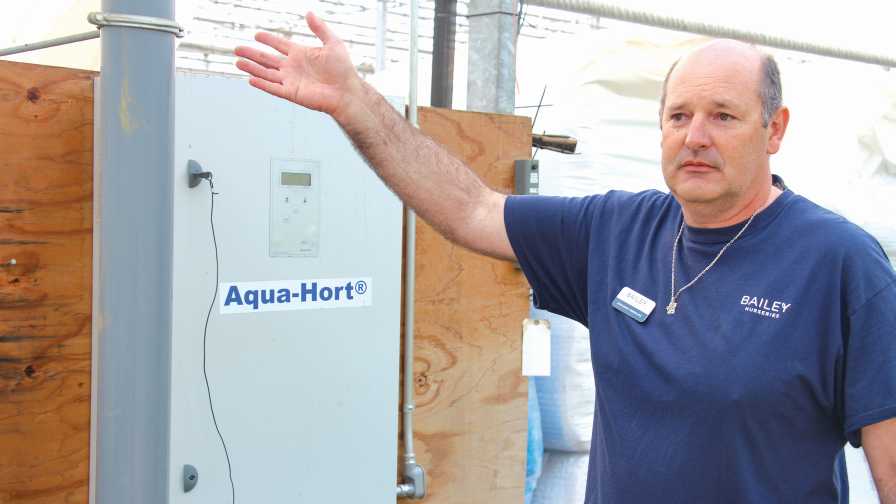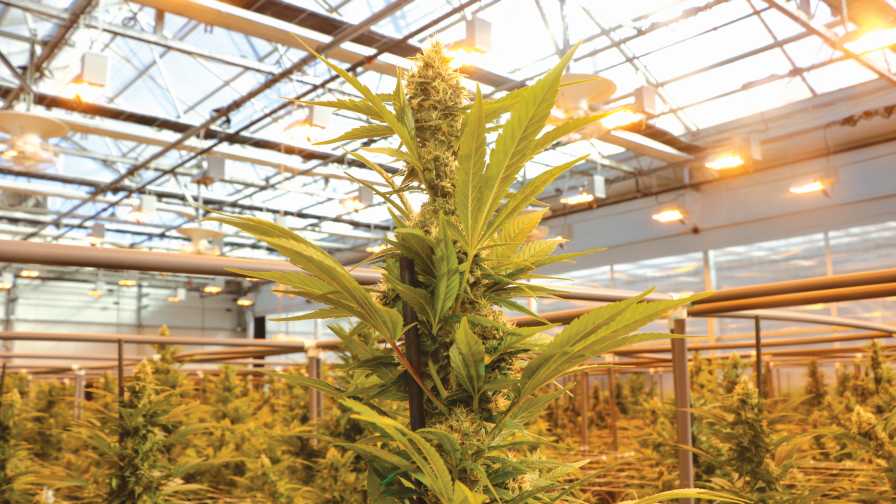What 2 Greenhouse Growers Did to Overcome Water Woes

At its annual Summer Expo, Bailey’s production manager Jean Marc Versolato led a behind-the-scenes tour of the nursery’s three-year old water ionization system, which automatically injects copper ions into irrigation water via an Aqua-Hort system produced in Denmark.
Photo by Matthew J. Grassi
Some growers have the luxury of building out a new greenhouse from scratch, and therefore right off the bat they can select a site that checks all of their boxes from a water standpoint. For most growers, however, the greenhouse where they grow may bring with it some inherent issues with the water source that will need to be overcome through treatment.
This, my friends, is where that old trusty sidekick technology typically comes into play.
Bailey’ Copper Ionization System
A multistate operation that produces plugs and liners in pristine greenhouse bays full of sand for young woody plant and shrub propagation, Bailey in Woodbury, MN, recently implemented a rather novel water-based solution to solve a problem many controlled environment growers face: fungal disease pressures (and volunteer algae) in the greenhouse.
About three growing seasons ago, according to Production Manager Jean Marc Versolato, the grower-distributor was looking to decrease its annual spend on fungicides as well as rid the greenhouses of some of the yield-robbing algae its crews were having to scrub from production bay walls between turns.
That’s when Versolato heard about some growers that were using a water-based copper ionization technology from Denmark to infuse irrigation water with copper ions, which were showing promise as a preventative for a number of common fungal pathogens as well as decreasing the overall amount of algae that gets into the greenhouses.
The system itself is rather simple and straightforward. Irrigation water is stored in giant 500-gallon tanks, inside of which are electrified copper rods that release dissolved copper into the irrigation water, which is then applied directly to the plants. A control panel is used to set rates, which in Bailey’s case they keep the machine set at 2 ppm per gallon, year-round.
“So, I said, ‘Let’s buy one and find out for ourselves,’” Versolato says. “And we found out that both (claims) happened to be true. The copper does a very good job controlling the algae in the sand, and the greenhouses are staying much cleaner than using chlorine alone. After about two or three years, we’ve seen a drastic reduction in bacterial issues like leaf spot and downy mildew.”
In fact, that copper ionization system worked so well that Versolato says Bailey hasn’t had to apply fungicide for downy mildew on its roses at all since installing the system, and there are plant health benefits as well.
“Our crops seem to be healthier and have more vigor, which we think can be based on a healthier root system (from the copper),” Versolato says.
The next natural question is whether Bailey uses a similar system at all of its sites nationwide, or whether it plans to put these systems in place in all of its greenhouses.
“Our folks on the West Coast in Oregon, where we have about 10 acres of greenhouse production, are looking at this now because of the benefits we’re seeing here in Minnesota,” Versolato says. “We’re still trying to figure out if they really want to do it or not, because it is a capital investment, so it is not exactly cheap.”
As far as measuring initial payback, for Versolato and the folks at Bailey, it’s tough to put a price tag on producing better jumps and starts than the competition.
“If you look at it as in algae control, disease prevention, and producing a healthier, better crop in the end, it is difficult for me to put a price tag on that,” he says. “It helps you be a better grower, and have a better crop, than the competition down the road, and that’s exactly what we’re trying to do – offer the best plant material to our customers.”

Michael Sassano, principal grower at Solaris Farms, Las Vegas, NV, inspects the hybrid greenhouses’ water treatment equipment prior to the start of another growing day.
Photo by Matthew J. Grassi
This Cannabis Grower Overcame Dirty Las Vegas City Water
With a moniker like “Sin City,” well, you can imagine all the outside contaminants that make it into the municipal water supply in Las Vegas, NV.
Which makes producing a consistently looking/tasting/smelling crop of legal cannabis flower even more difficult. Not to mention the arid desert climate and the cutthroat nature of the adult-use legal cannabis market in Vegas, a city overrun with tourists and picky locals all looking for the best of the best.
Michael Sassano knows these facts all too well, being the principal grower at Solaris Farms, one of the largest commercial cannabis cultivation operations in the state of Nevada. For Solaris’ 12-acre hybrid greenhouse located just a stone’s throw from the famous Las Vegas Strip, a dialed-in water supply was one of the first hurdles the group needed to overcome to begin supplying the city’s vast retail network with high-quality cannabis flowers.
“For this plant, the water source is extremely important,” Sassano stresses. “If you’re using city water, there is everything from contaminants to the calcium and fluoride that the city water treatment plant puts into it. They’re treating water on such a max scale, that for the purposes of growing plants it can’t be all that clean. If you’re in the city like we are, you’ve got to scrub it a lot more.”
Solaris pulls in city water through an industrial sized Culligan water softener, then filters the water through a 4:1 reverse osmosis system. After that, the water is sent to giant storage barrels where it undergoes an ultraviolet light treatment for any contaminants that survived the first steps of the process.
“I suppose we could be doing even more (water treatment) if we wanted to, but we test it every month and every month there’s nothing (bad) in it,” Sassano says. “One time we did find some microbes that got stuck in our wet walls, so we had to clean those things down tremendously.”
Sassano says growers in rural areas out in the countryside probably won’t have to go to the extremes the group at Solaris did, since water in the country is generally cleaner than city water, but any water treatment strategy must be implemented in an economical way. In other words, don’t go broke trying to treat water.
“Everything starts, even before you start growing, with a water test and finding out what you have in your water,” Sassano says. “But, no matter what, if you take your first step and second step and third step to growing perpetually, clean water should always be an objective. You don’t want to be introducing stuff from your water source, and it ends up in the cellular level of the plant.”

Just like any ornamental plant grown to commercial scale, cannabis plants require a certain quality of water to thrive and consistently produce biomass.
Photo by Matthew J. Grassi
At-A-Glance Grower Takeaways
- When setting up a grow, one of the first steps should be a site water analysis to find out what issues you’re going to be dealing with water-wise.
- Don’t put a price tag on plant quality when it comes to investing in water treatment systems that will allow you to grow more, better.
- Whether you’re pulling from municipally treated water sources or rural well water will likely determine the extent to which you’ll need water treatment equipment and systems;
- There is no one-size-fits-all approach for water; every individual site will bring along its own unique set of challenges and opportunities. Be open-minded and ready for anything.










